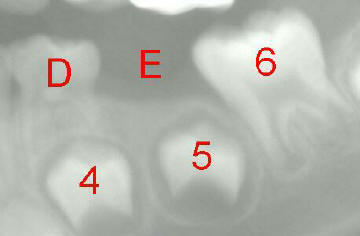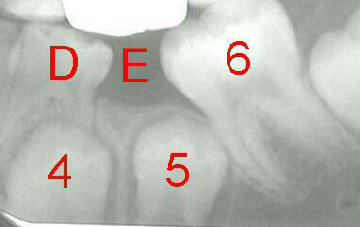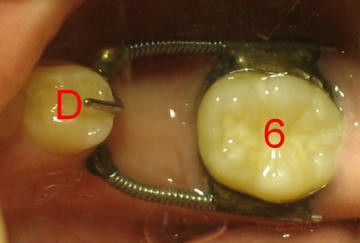 |
 |
|
Fig.1 |
Fig.2 |
|
|
 |
|
Fig.3 |
Fig.4 |
 |
|
| Fig.5 | |
 |
 |
|
Fig.1 |
Fig.2 |
|
|
 |
|
Fig.3 |
Fig.4 |
 |
|
| Fig.5 | |
Dental Education Lecture: Space Maintenance Part II: a Clinical Case
In last lecture, we use drawing to show why we need space maintenance when a baby molar tooth is lost too early. In this lecture, we are going to use a clinical case show you what will happen if we do not install space maintenance promptly.
Annie is a lovely 9-year-old girl. One year and half years ago, she came to our office for new patient exam with mom. A baby tooth, E, was extracted one month earlier (Fig.1). E is supposed to fall out naturally around the age of 12. X-ray demonstrates that there was plenty of space in the missing tooth area for the underlying tooth (#5) to grow into. In other word, the width of the missing tooth area is larger than that of the underlying tooth. We recommended space maintenance immediately, but the mom did not bring her back until recently. We retook X-ray. The latter reveals that the missing tooth space had become much narrower (Fig.2) as compared to that of Fig.1 . This time the width of the missing tooth area (E) is smaller than that the underlying tooth (5). That is, there is no room for the underlying adult tooth to erupt. The space has become narrower due to tilting and shifting of neighboring teeth toward it when we compare Fig.1 and 2. As you may notice, things change very quickly in a growing child. Do not ignore doctor's advice.
When space maintenance is ready, we should bring the kid back for cementation immediately. Procrastination can also cause losing the space.
When the space is lost, we need to install a special device called space regainer (Fig.3) to restore the space and facilitate the underlying permanent tooth to come into this world. Due to the action of the spring, the space between D and 6 is increased substantially in 2.5 months (Fig.4). Fig.1 and 2 are lateral view (X-ray) of back teeth, whereas Fig.3 and 4 are occlusal view. D is the first baby molar, whereas 6 is the first adult molar. 4 and 5 stand for the 1st and 2nd premolars, respectively.
Annie disappears from the planet for another 1.5 years. Finally she returns to our office with her parents, simply because daddy needs a filling. According to her mom, Annie is doing great. She does not need anything except cleaning. To our dismay, Annie has lost space regainer for more than a year. The space for the 2nd premolar (5) has lost again (Fig.5), most likely due to shifting of the 1st molar (arrow, 6). The 2nd premolar on the other side (5') has already made its appearance in the world. Once again, changes happen quickly in children. They need to be watched closely.
Next lecture, we will show you what space maintenance looks like and what we should do if the space is lost. See you.
Xin Wei, DDS, PhD, MS 1st edition 01/17/2009, last revision 07/16/2012